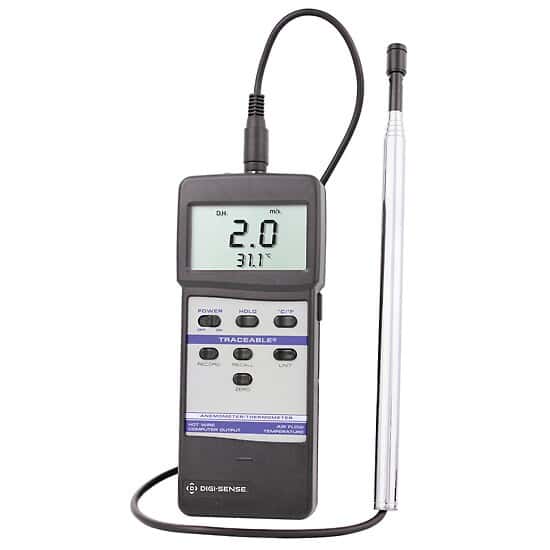What is Hot Wire Anemometer?
At its core, a hot wire anemometer is a sophisticated instrument utilized to measure the velocity of air flow. Unlike conventional methods, such as mechanical vane anemometers, which rely on moving parts, hot wire anemometers operate on a principle of heat transfer to determine airflow velocity with exceptional accuracy.

How Does a Hot Wire Anemometer Work?
The functionality of a hot wire anemometer revolves around the concept of convective heat transfer. A thin wire, typically made of platinum, is heated to a constant temperature using electrical current. As air flows over the wire, it carries away heat, causing a change in the wire's resistance. By monitoring this change in resistance, the instrument can precisely calculate the velocity of the air flow. This method offers a rapid response time, making hot wire anemometers particularly adept at capturing fluctuating air velocities. Helpful resource: https://www.degreec.com/hot-wire-anemometer-applications/#:~:text=A%20Hot%20Wire%20Anemometer%20is,the%20temperature%20of%20wire%20reduces.
How Accurate is the Hotwire Anemometer?
One of the primary attributes of hot wire anemometers is their remarkable accuracy. These instruments can measure air velocities ranging from fractions of a meter per second to several tens of meters per second with high precision. Their sensitivity to even subtle changes in airflow ensures reliable data collection in various environmental conditions. Helpful resource: https://www.instrumentchoice.com.au/news/what-is-a-hot-wire-anemometer#:~:text=Accuracy%3A%20From%200%20to%202,%2Fs%20%2B%205%20%25%20of%20m.v.
What is the Difference Between Hot Wire and Vane Anemometer?
While both hot wire and vane anemometers serve the purpose of measuring air velocity, they operate on fundamentally different principles. Vane anemometers employ rotating cups or blades to detect airflow, whereas hot wire anemometers rely on heat transfer. The latter offers superior sensitivity and response time compared to mechanical vane counterparts, making it more suitable for demanding applications requiring precise measurements. Helpful resource: https://in.omega.com/prodinfo/anemometers.html#:~:text=The%20vane%20anemometer%2C%20thermal%20anemometer,measurements%20in%20a%20cross%2Dsection.
What are the Advantages and Disadvantages of Hot Wire Anemometer?
Advantages:
- High accuracy and precision.
- Rapid response time.
- Minimal interference with airflow due to the absence of moving parts.
- Suitable for measuring low air velocities.
Disadvantages:
- Susceptibility to damage from excessive air velocities.
- Calibration and maintenance requirements due to the sensitivity of the heating element.
- Higher initial cost compared to mechanical anemometers.
Helpful resource: https://www.renkeer.com/anemometer-types/#:~:text=Advantages%3A%20It%20is%20a%20high,most%20important%20sources%20of%20error.
What Type of Anemometer is Most Accurate?
While hot wire anemometers are renowned for their precision, the choice of the most accurate type of anemometer depends on the specific requirements of the application. For instance, in environments with turbulent airflow or low velocities, hot wire anemometers excel, whereas in harsh industrial settings, other types such as ultrasonic anemometers might be preferred for their robustness. Helpful resource: https://www.munroinstruments.com/anemometer-definition-types-work-process/#:~:text=It%20consists%20of%20four%20cups,are%20very%20accurate%20and%20precise.
What is the Drawback of Hot Wire Instrument?
Despite its numerous advantages, the hot wire anemometer is not without its limitations. One significant drawback is its susceptibility to damage when exposed to high air velocities. Additionally, the delicate nature of the heating element necessitates careful handling and regular calibration to maintain accuracy over time. Helpful resource: https://www.test-and-measurement-world.com/Terminology/Advantages-and-Disadvantages-of-Hot-wire-Instruments.html#:~:text=Drawbacks%20or%20disadvantages%20of%20Hot%20wire%20instruments&text=%E2%9E%A8Power%20consumption%20is%20relatively,for%20ascending%20and%20descending%20values.
In conclusion, hot wire anemometers represent a pinnacle of precision in air flow measurement technology. Their ability to provide accurate data swiftly makes them indispensable tools across various industries and scientific disciplines. While they may have some drawbacks, their unmatched performance in capturing intricate airflow dynamics solidifies their status as a cornerstone of modern instrumentation.
Facts Checked by Hugh Johnson
Hugh Johnson stands tall in the realms of both the chip industry and the electronic parts industry, earning acclaim as an esteemed expert in these fields. With an extensive background steeped in semiconductor technology, Hugh's expertise transcends chip design and fabrication, encompassing a profound understanding of electronic components' intricate functionalities and applications. His seasoned knowledge spans diverse facets, from microchip architecture and fabrication techniques to the broader landscape of electronic parts utilized across industries.









